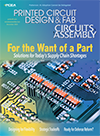Uncategorised
EnviroMark 907 (EM907) is a no-clean, lead-free solder paste.
Designed for high-yield, lead-free manufacturing, was
engineered specifically for the higher thermal demands and higher melting temperature
lead-free alloys, such as the SnAgCu (SAC) alloys. Features a long
stencil life, offers lead-free joints that closely resemble those achieved with
Sn/Pb solder paste. Capable of extended downtimes in printing, maintains
excellent print quality at print speeds up to 6 in/sec. (150 mm/sec). Has
excellent cold and hot slump behavior, preventing bridges and solder ball
formation. Said to have excellent solderability to a variety of board surface
metallizations, including OSP, Ni/Au, Immersion Sn and Immersion Ag. Features
solderability to an array of component metallizations, including Pd/Ag and
Alloy 42. Flux chemistry offers bright solder joints, even in air reflow.
This cosmetic feature is an added benefit during inspection. The paste leaves
only a light-colored residue and provides a stable tack life.
Reflowable
in air or nitrogen, prints down to 0201 pad sites, has superior printing
characteristics to 16 and 20 mil pitches (0.4 and 0.5 mm) and meets J-STD-004
Flux Classification ROL0.
Kester, kester.com, Booth 5636
Christopher
Associates will introduce two automatic optical inspection systems, as well as
a laser robotic soldering system. NSpec DL 18 is the latest addition to the
Marantz (Tokyo, Japan) AOI product line. Offers
high speed first article inspection, advanced illumination and very high
resolution optics, can even inspect 01005 components at very high speeds. KY
3020T bench top, 3-D solder paste inspection system from Koh Young Technology (Seoul, Korea)
offers the accuracy and speed of the standard inline systems for high mix/low
volume applications. Model 414L laser robotic soldering system from Japan Unix
Co. Ltd. was developed for lead-free processing with reduced cost of ownership.
Christopher Associates, christopherweb.com, Booth 6120
Fineplacer
CRS10 compact rework system is useful for small- to medium-scale series
assembly or precise rework of soldered components on medium to large SMD
boards. Features a Plug-and-Work design, Vision Alignment System with
stationary beam splitter, controlled z height during reflow and an automated
component place and liftoff function.
Finetech, finetechusa.com, Booth 5002
DDf, in the Direct Die Feeding product line, can feed
a range of bare die and flip chips, and can be mounted on almost every
placement machine. Performance is optimized around the handling of
small flip chips. Capable of feeding die to 0.5 mm sq. with a
throughput over 6,000 die/hr.
Hover-Davis, hoverdavis.com, Booth 6040
Hover-Davis, hoverdavis.com, Booth 6040
FLX2010 SMD pick-and-place has 190 feeders. Can place 5,000 cph, including 0201
or ultra-fine pitch 0.3 mm components, as well as condensators up to 15 mm,
large connectors and 50 mm BGAs. Features laser and vision centering systems.
Management system automatically recognizes feeders and pickup height. LEDs show
the feeder status.
Essemtec, essemtec-usa.com, Booth 5438
Summit 1800 is for
Pb-free rework for large components. A 65-mm alignment field of view with
digital and optical zoom and split image ensure placement of large packages,
sockets and connectors. Has programmable, motor-controlled top heater
positioning and automatic prism shuttle. Incorporates independent, programmable
motions for pick-up and top heater height.
VJ Electronix Inc., vjelectronix.com, Booth 5626


